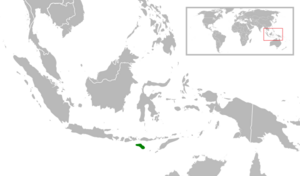Apricot-breasted sunbird facts for kids
Quick facts for kids Apricot-breasted sunbird |
|
|---|---|
 |
|
| Conservation status | |
| Scientific classification | |
| Genus: |
Cinnyris
|
| Species: |
buettikoferi
|
 |
|
The apricot-breasted sunbird (Cinnyris buettikoferi) is a small, colorful bird. It belongs to the Nectariniidae family, also known as sunbirds. This special bird only lives on the island of Sumba in Indonesia. It likes to live in warm, wet forests, both in low areas and on mountains. Even though there are many of these birds, scientists don't know much about their daily lives, like what they eat or how they raise their young.
Contents
What is the Apricot-breasted Sunbird?
The apricot-breasted sunbird is a medium-sized sunbird. It measures about 11 cm (4.3 in) long. That's about the length of a pen!
How to Identify a Male Sunbird
Male apricot-breasted sunbirds have an olive-brown back and neck. Their head is a bit greyer-brown. Their tail is blackish and shiny, with brown tips. Their wing feathers are brown with green edges.
The underside of the male bird is mostly yellow. But from his chin to his upper chest, he has a shiny purplish-blue patch. Below that, there's a bright orange band across his chest. This is where the "apricot-breasted" part of its name comes from!
How to Identify a Female Sunbird
Female apricot-breasted sunbirds look similar to the males. However, their entire underside is yellow. They also have olive-green sides on their chest.
Other Features
Both male and female birds have blackish feet. Their eyes are dark brown. The male's bill is black. The female's bill is dark brown. Young apricot-breasted sunbirds have not been described yet. This means scientists don't know what they look like.
Where Do Apricot-breasted Sunbirds Live?
This bird is endemic to the island of Sumba. This means it lives only on Sumba and nowhere else in the world. You can find them from sea level up to at least 950 m (3,120 ft) high in the mountains.
What Do We Know About Their Lives?
Even though the apricot-breasted sunbird is common on Sumba, we don't know much about its daily habits. Scientists estimate there are about 750,000 of these birds.
Daily Habits
These birds are usually easy to spot. They are often seen alone or in pairs. They mostly look for food in the middle and upper parts of trees. Sometimes they go lower.
Diet and Breeding
Scientists don't know what these birds eat. Their diet is a mystery! Their breeding habits are also unknown. We don't know how they find a mate, what their nests look like, or what their eggs or young are like.
Are Apricot-breasted Sunbirds Endangered?
The apricot-breasted sunbird is rated as a species of least concern. This means it is not considered endangered. The International Union for Conservation of Nature gave it this rating.
This is because the bird has a large population. It also seems to be stable. Even though it only lives on Sumba, it can be found all over the island. Sumba is an area of about 13,100 km2 (5,100 sq mi).
Naming the Sunbird
A German ornithologist (a bird scientist) named Ernst Hartert first described this bird in 1896. He gave it the scientific name Cinnyris büttikoferi. He used a bird he found on Sumba to describe it.
The name Cinnyris comes from an old Greek word. It was used for a small, unknown bird. The species name, büttikoferi, honors a Swiss zoologist named Johann Büttikofer. He had seen female birds but didn't name them as a new species because he hadn't seen any males.


